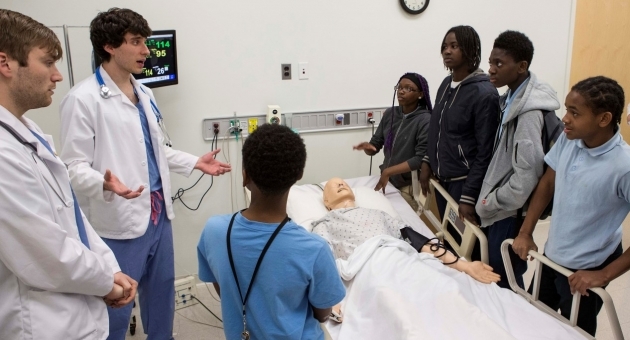Medical students expose middle schoolers to health careers

It’s 2 p.m. on a Friday, and eighth graders from the Mary McLeod Bethune School in Philadelphia are taking each other’s blood pressure, working with laparoscopic surgery simulators and participating in an emergency room simulation.
It’s all part of Health Careers Day with Science in Philly Schools (SiPS), an organization at Temple University School of Medicine run entirely by medical students. Through weekly, hands-on laboratory lessons, SiPS helps to supplement the school’s science curriculum. The annual Health Careers Day is designed to expose students to careers in the medical field.
“It’s been mutually beneficial to us and the kids,” said SiPS founder and past president Kathryn Stockbower, a fourth-year medical student. “Seeing kids have these ‘aha’ moments is really rewarding. We want to make science fun for them.”
Stockbower launched the organization in 2012 when she and a group of students were informed by a community member that the nearby Mary McLeod Bethune School had minimal resources, particularly in science.
She began working directly with the school’s science teachers to enhance the curriculum—and students’ interest and engagement with science. Today, SiPS is thriving, with dozens of members and constant activity.
“It really inspires the kids,” said Rachel Dillinger, SiPS president and first-year medical student. “I didn’t have the opportunity to do anything like this growing up.”
During Health Careers Day, students were exposed to various aspects of the medical field as they rotated through workshops. Through advanced technology, a mannequin patient responded to students’ questions to help them make a diagnosis during a simulated medical emergency.
Following the exercises, Deric Savior, director of medical lung cancer at Temple University Hospital, led a motivational, interactive lecture. Emphasizing the importance of having options for the future, he told students, “It doesn’t matter where you came from, only where you are going.”
Savior, himself, can relate. Raised in the same Philadelphia neighborhood as these students, he witnessed friends make poor decisions and take the wrong paths in life. He knew he didn’t want to make the same mistakes. While considering his future, Savior said one day he “had an epiphany to go to medical school” and worked diligently to make that happen.
The goal of the program is to inspire these students to set similar goals.
“I learned CPR, how to take someone’s pulse and how to help people,” said eighth-grader Stephanie Cruz. “And I had fun.”
Classmate Kiara Wilson agreed. “I learned how you need to specifically pick someone to call 911 when someone can’t breathe.”
Their teacher, Donna Podolsky, believes the program has been beneficial to her classes. “The medical students bring equipment to the classroom that we don’t have at the school. This gives the students access to things they’d never ordinarily see.”
“I think it’s given them more personalized attention, exposure to deeper things in science and the ability to see the perspectives of other people. It’s made them want to help each other.”
- Erica Brooke Fajge